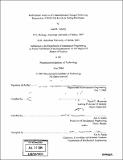| dc.contributor.advisor | David E. Housman. | en_US |
| dc.contributor.author | Tabchy, Adel B. (Adel Bassam), 1976- | en_US |
| dc.contributor.other | Massachusetts Institute of Technology. Dept. of Mechanical Engineering. | en_US |
| dc.date.accessioned | 2005-09-06T21:55:26Z | |
| dc.date.available | 2005-09-06T21:55:26Z | |
| dc.date.copyright | 2004 | en_US |
| dc.date.issued | 2004 | en_US |
| dc.identifier.uri | http://hdl.handle.net/1721.1/27136 | |
| dc.description | Thesis (S.M.)--Massachusetts Institute of Technology, Dept. of Mechanical Engineering, 2004. | en_US |
| dc.description | Includes bibliographical references (leaves 126-129). | en_US |
| dc.description.abstract | We have identified the genes responsible for SERCA2a-induced reversal of heart failure, the leading cause of morbidity and mortality in the United States and developed countries. We have previously shown that restoration of a key enzyme that controls intracellular Ca2+ handling, the Sarcoplasmic Reticulum Ca2+ ATPase (SERCA2a), induces reversal of heart failure in humans and experimental models. We used high-density oligonucleotide arrays to explore the genetic reprogramming responsible for the reversal of heart failure upon adenoviral gene transfer of SERCA2a in a rat model of pressure overload hypertrophy in transition to heart failure. We combined model- and data-driven approaches to analyze the resulting multivariate microarray expression dataset corresponding to 4237 transcript sequences in six experimental groups. A multiscale systems approach was used that incorporated the main mechanisms underlying the control of gene expression at the transcriptional level, and the pathologic compensatory responses that occur in heart failure. The combinatorial control of gene expression that is thought to occur in mammals was implemented in a signal-processing model at the level of the heart cell nucleus; it identified 473 SERCA2a regulated genes. The integration of the main mechanisms underlying the pathologic compensatory responses that take place in heart failure was fundamental to the discovery of 10 functional transcriptional classes within this group of genes. In addition, 226 genes that were not targets of SERCA2a but were natural adaptive responses to aortic banding needed for clinical non-failure, were identified and functionally categorized. Biological functional distribution of SERCA2a targets revealed that SERCA2a activates genes | en_US |
| dc.description.abstract | (cont.) that function mainly in the cytoskeleton, ECM, Ca2+ signaling, signal transduction, cell cycle and growth and development pathways. The integration of model- and data-driven ideas was crucial to the elucidation of specific patterns in the multivariate data and allowed the discovery of novel genes and their potential role in the normalization of multiple pathways within the failing cell. This is a novel, powerful and portable method to elucidate multivariate genome-wide transcriptional networks from primary microarray data. | en_US |
| dc.description.statementofresponsibility | by Adel B. Tabchy. | en_US |
| dc.format.extent | 140 leaves | en_US |
| dc.format.extent | 5240009 bytes | |
| dc.format.extent | 5257523 bytes | |
| dc.format.mimetype | application/pdf | |
| dc.format.mimetype | application/pdf | |
| dc.language.iso | en_US | |
| dc.publisher | Massachusetts Institute of Technology | en_US |
| dc.rights | M.I.T. theses are protected by copyright. They may be viewed from this source for any purpose, but reproduction or distribution in any format is prohibited without written permission. See provided URL for inquiries about permission. | en_US |
| dc.rights.uri | http://dspace.mit.edu/handle/1721.1/7582 | |
| dc.subject | Mechanical Engineering. | en_US |
| dc.title | Multivariate analysis of transcriptional changes following restoration of SERCA2a levels in failing rat hearts | en_US |
| dc.type | Thesis | en_US |
| dc.description.degree | S.M. | en_US |
| dc.contributor.department | Massachusetts Institute of Technology. Department of Mechanical Engineering | |
| dc.identifier.oclc | 56889189 | en_US |
